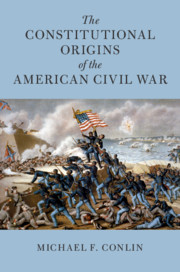Book contents
- The Constitutional Origins of the American Civil War
- Cambridge Historical Studies in American Law and Society
- The Constitutional Origins of the American Civil War
- Copyright page
- Dedication
- Contents
- Figures
- Tables
- Preface
- Acknowledgments
- Abbreviations
- Terms
- 1 The Original Intent of the Slaveholding Founders
- 2 Two Constitutional Wrongs Did Not Guarantee a Constitutional Right
- 3 The Tyranny of the Northern Majority
- 4 The Spirit of 1787
- 5 The Constitutional Right of Secession
- Epilogue
- Charts Showing the Authors of Manuscript Sources Cited
- Charts Showing the South’s Minority Status in the Federal Government
- Select Bibliography
- Index
5 - The Constitutional Right of Secession
Published online by Cambridge University Press: 28 June 2019
- The Constitutional Origins of the American Civil War
- Cambridge Historical Studies in American Law and Society
- The Constitutional Origins of the American Civil War
- Copyright page
- Dedication
- Contents
- Figures
- Tables
- Preface
- Acknowledgments
- Abbreviations
- Terms
- 1 The Original Intent of the Slaveholding Founders
- 2 Two Constitutional Wrongs Did Not Guarantee a Constitutional Right
- 3 The Tyranny of the Northern Majority
- 4 The Spirit of 1787
- 5 The Constitutional Right of Secession
- Epilogue
- Charts Showing the Authors of Manuscript Sources Cited
- Charts Showing the South’s Minority Status in the Federal Government
- Select Bibliography
- Index
Summary
Chapter 5 demonstrates that the constitutional crisis over slavery reached the point of no return by 1860. Having no prospect of gaining majorities in Congress, the Southern minority believed that the presidency offered the main protection for slavery. Thus, Southerners were alarmed at the prospect of the election of Abraham Lincoln in 1860. They feared that his victory augured the beginning of a “dynasty” of antislavery presidents, who would abolish slavery. In response to the unprecedented event of the inauguration of an avowedly antislavery president, seven Southern states seceded. Citing compact theory, some Southerners claimed that secession was a constitutional right. In contrast, most Northerners rejected secession as an existential threat to the Constitution itself. Unfortunately, the Constitution permitted ambiguous readings of the matters in dispute. If the constitutionality of secession was uncertain, then so was federal coercion of the seceded states. If the states could not secede, but the federal government could not compel them to return to the Union, then the only solution was compromise. As the previous grand compromises had not solved the disputes surrounding slavery, there was widespread agreement that an amendment was necessary. Unfortunately, the Constitution made passing an amendment nearly impossible during a crisis.
- Type
- Chapter
- Information
- The Constitutional Origins of the American Civil War , pp. 182 - 222Publisher: Cambridge University PressPrint publication year: 2019

